oil temperature JEEP WRANGLER 2015 JK / 3.G Owners Manual
[x] Cancel search | Manufacturer: JEEP, Model Year: 2015, Model line: WRANGLER, Model: JEEP WRANGLER 2015 JK / 3.GPages: 695, PDF Size: 20.64 MB
Page 303 of 695
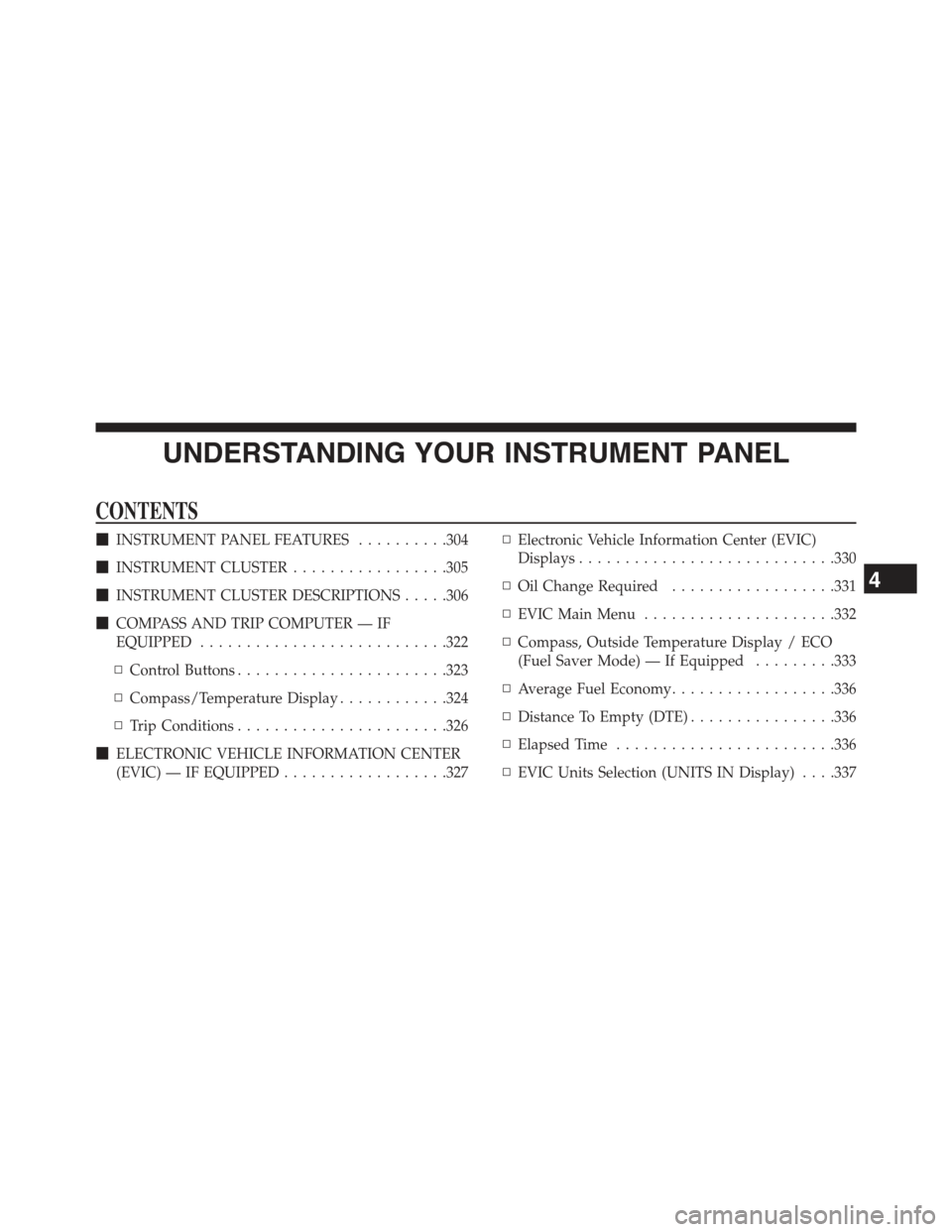
UNDERSTANDING YOUR INSTRUMENT PANEL
CONTENTS
!INSTRUMENT PANEL FEATURES..........304
!INSTRUMENT CLUSTER.................305
!INSTRUMENT CLUSTER DESCRIPTIONS.....306
!COMPASS AND TRIP COMPUTER — IF
EQUIPPED...........................322
▫Control Buttons.......................323
▫Compass/Temperature Display............324
▫Trip Conditions.......................326
!ELECTRONIC VEHICLE INFORMATION CENTER
(EVIC) — IF EQUIPPED..................327
▫Electronic Vehicle Information Center (EVIC)
Displays............................330
▫Oil Change Required..................331
▫EVIC Main Menu.....................332
▫Compass, Outside Temperature Display / ECO
(Fuel Saver Mode) — If Equipped.........333
▫Average Fuel Economy..................336
▫Distance To Empty (DTE)................336
▫Elapsed Time........................336
▫EVIC Units Selection (UNITS IN Display) . . . .337
4
Page 315 of 695
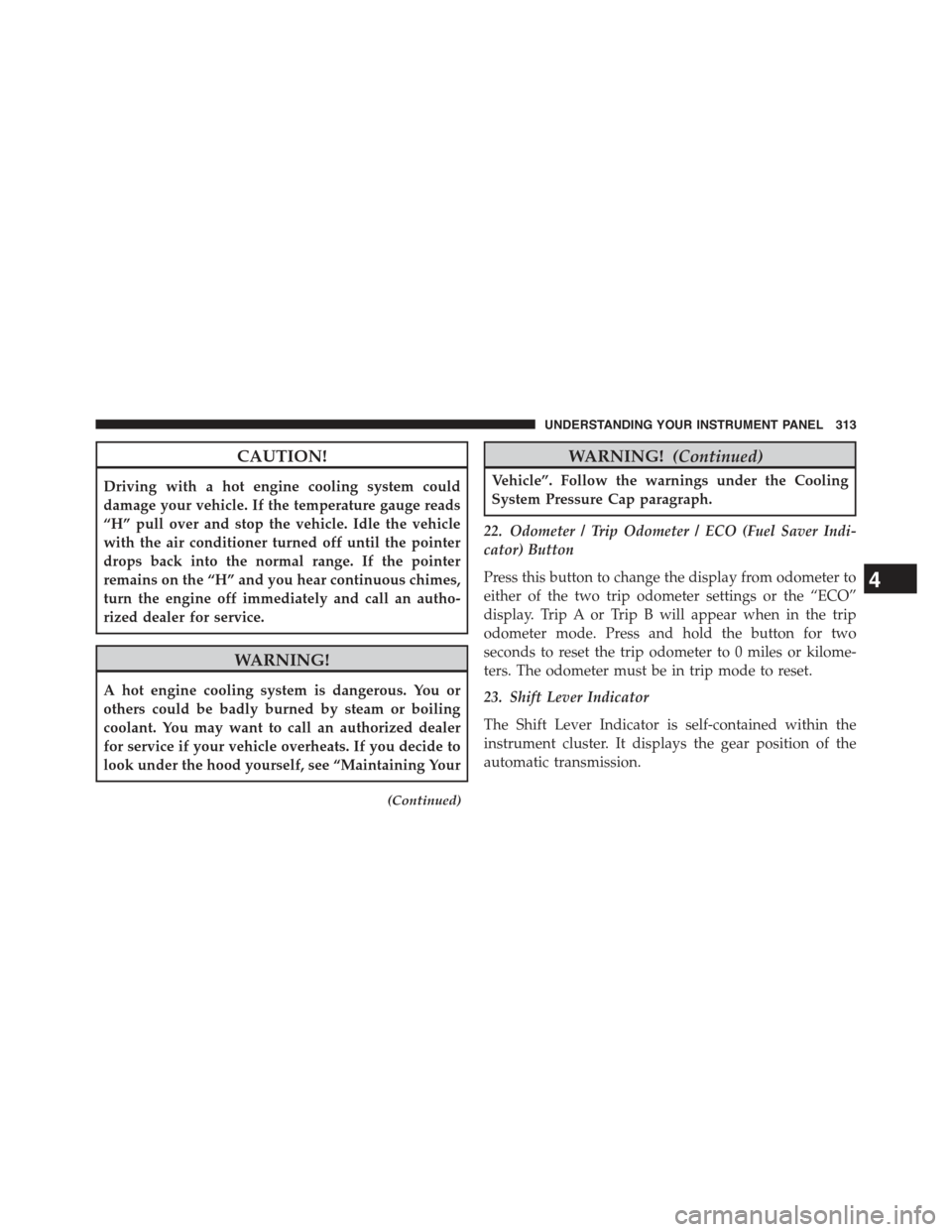
CAUTION!
Driving with a hot engine cooling system could
damage your vehicle. If the temperature gauge reads
“H” pull over and stop the vehicle. Idle the vehicle
with the air conditioner turned off until the pointer
drops back into the normal range. If the pointer
remains on the “H” and you hear continuous chimes,
turn the engine off immediately and call an autho-
rized dealer for service.
WARNING!
A hot engine cooling system is dangerous. You or
others could be badly burned by steam or boiling
coolant. You may want to call an authorized dealer
for service if your vehicle overheats. If you decide to
look under the hood yourself, see “Maintaining Your
(Continued)
WARNING!(Continued)
Vehicle”. Follow the warnings under the Cooling
System Pressure Cap paragraph.
22. Odometer / Trip Odometer / ECO (Fuel Saver Indi-
cator) Button
Press this button to change the display from odometer to
either of the two trip odometer settings or the “ECO”
display. Trip A or Trip B will appear when in the trip
odometer mode. Press and hold the button for two
seconds to reset the trip odometer to 0 miles or kilome-
ters. The odometer must be in trip mode to reset.
23. Shift Lever Indicator
The Shift Lever Indicator is self-contained within the
instrument cluster. It displays the gear position of the
automatic transmission.
4
UNDERSTANDING YOUR INSTRUMENT PANEL 313
Page 317 of 695
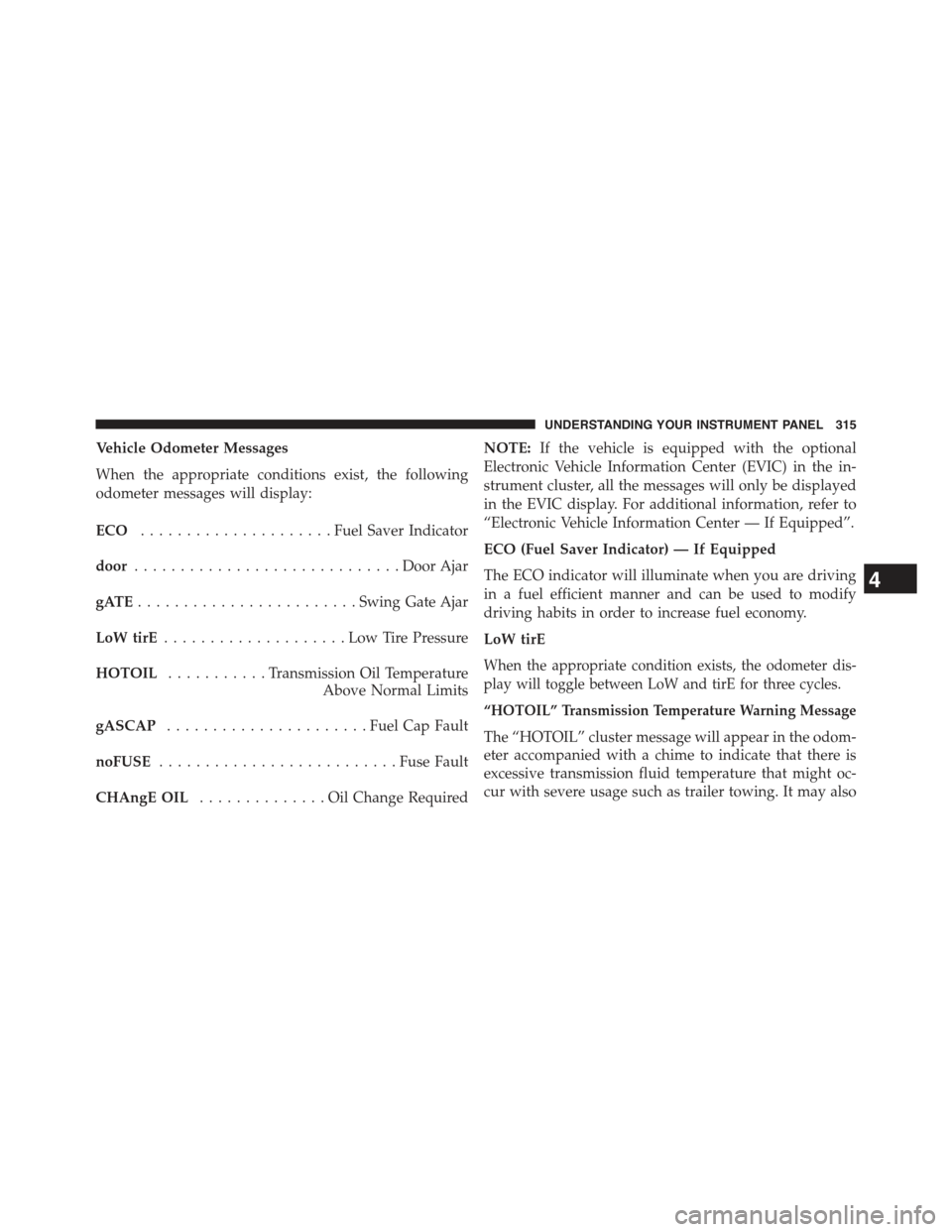
Vehicle Odometer Messages
When the appropriate conditions exist, the following
odometer messages will display:
ECO.....................Fuel Saver Indicator
door.............................Door Ajar
gATE........................Swing Gate Ajar
LoW tirE....................LowTirePressure
HOTOIL...........Transmission Oil Temperature
Above Normal Limits
gASCAP......................Fuel Cap Fault
noFUSE..........................Fuse Fault
CHAngE OIL..............OilChange Required
NOTE:If the vehicle is equipped with the optional
Electronic Vehicle Information Center (EVIC) in the in-
strument cluster, all the messages will only be displayed
in the EVIC display. For additional information, refer to
“Electronic Vehicle Information Center — If Equipped”.
ECO (Fuel Saver Indicator) — If Equipped
The ECO indicator will illuminate when you are driving
in a fuel efficient manner and can be used to modify
driving habits in order to increase fuel economy.
LoW tirE
When the appropriate condition exists, the odometer dis-
play will toggle between LoW and tirE for three cycles.
“HOTOIL” Transmission Temperature Warning Message
The “HOTOIL” cluster message will appear in the odom-
eter accompanied with a chime to indicate that there is
excessive transmission fluid temperature that might oc-
cur with severe usage such as trailer towing. It may also
4
UNDERSTANDING YOUR INSTRUMENT PANEL 315
Page 318 of 695
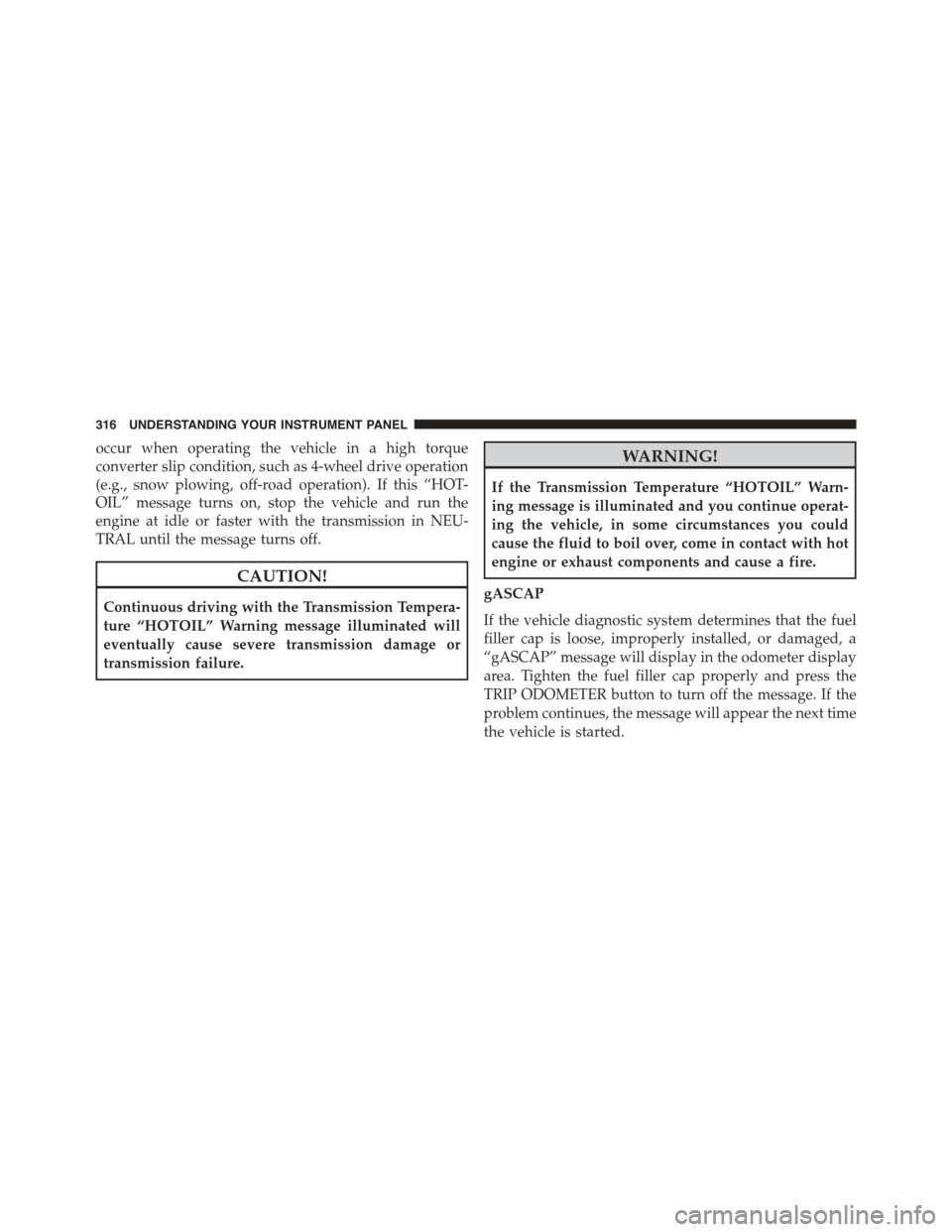
occur when operating the vehicle in a high torque
converter slip condition, such as 4-wheel drive operation
(e.g., snow plowing, off-road operation). If this “HOT-
OIL” message turns on, stop the vehicle and run the
engine at idle or faster with the transmission in NEU-
TRAL until the message turns off.
CAUTION!
Continuous driving with the Transmission Tempera-
ture “HOTOIL” Warning message illuminated will
eventually cause severe transmission damage or
transmission failure.
WARNING!
If the Transmission Temperature “HOTOIL” Warn-
ing message is illuminated and you continue operat-
ing the vehicle, in some circumstances you could
cause the fluid to boil over, come in contact with hot
engine or exhaust components and cause a fire.
gASCAP
If the vehicle diagnostic system determines that the fuel
filler cap is loose, improperly installed, or damaged, a
“gASCAP” message will display in the odometer display
area. Tighten the fuel filler cap properly and press the
TRIP ODOMETER button to turn off the message. If the
problem continues, the message will appear the next time
the vehicle is started.
316 UNDERSTANDING YOUR INSTRUMENT PANEL
Page 334 of 695
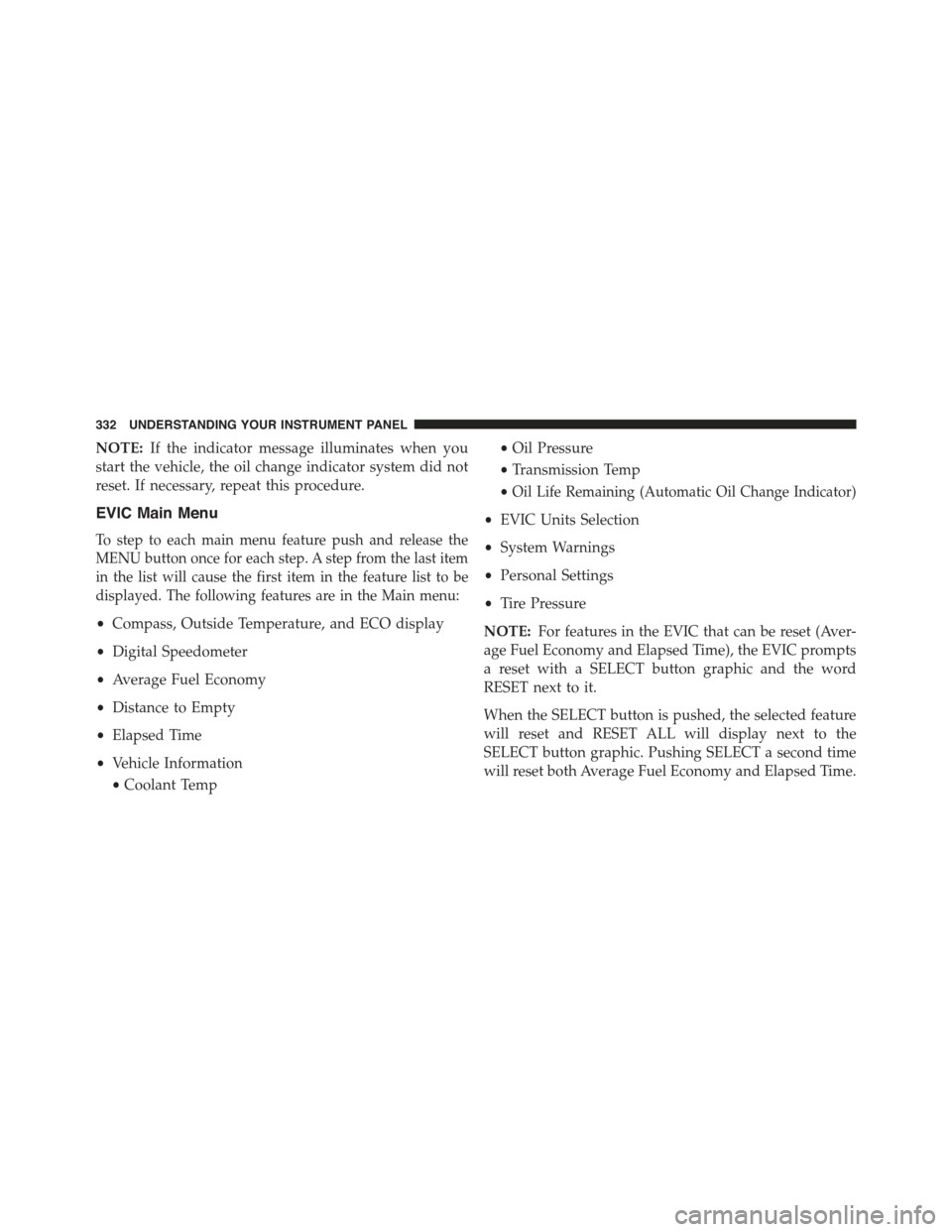
NOTE:If the indicator message illuminates when you
start the vehicle, the oil change indicator system did not
reset. If necessary, repeat this procedure.
EVIC Main Menu
To step to each main menu feature push and release the
MENU button once for each step. A step from the last item
in the list will cause the first item in the feature list to be
displayed. The following features are in the Main menu:
•Compass, Outside Temperature, and ECO display
•Digital Speedometer
•Average Fuel Economy
•Distance to Empty
•Elapsed Time
•Vehicle Information
•Coolant Temp
•Oil Pressure
•Transmission Temp
•Oil Life Remaining (Automatic Oil Change Indicator)
•EVIC Units Selection
•System Warnings
•Personal Settings
•Tire Pressure
NOTE:For features in the EVIC that can be reset (Aver-
age Fuel Economy and Elapsed Time), the EVIC prompts
a reset with a SELECT button graphic and the word
RESET next to it.
When the SELECT button is pushed, the selected feature
will reset and RESET ALL will display next to the
SELECT button graphic. Pushing SELECT a second time
will reset both Average Fuel Economy and Elapsed Time.
332 UNDERSTANDING YOUR INSTRUMENT PANEL
Page 339 of 695
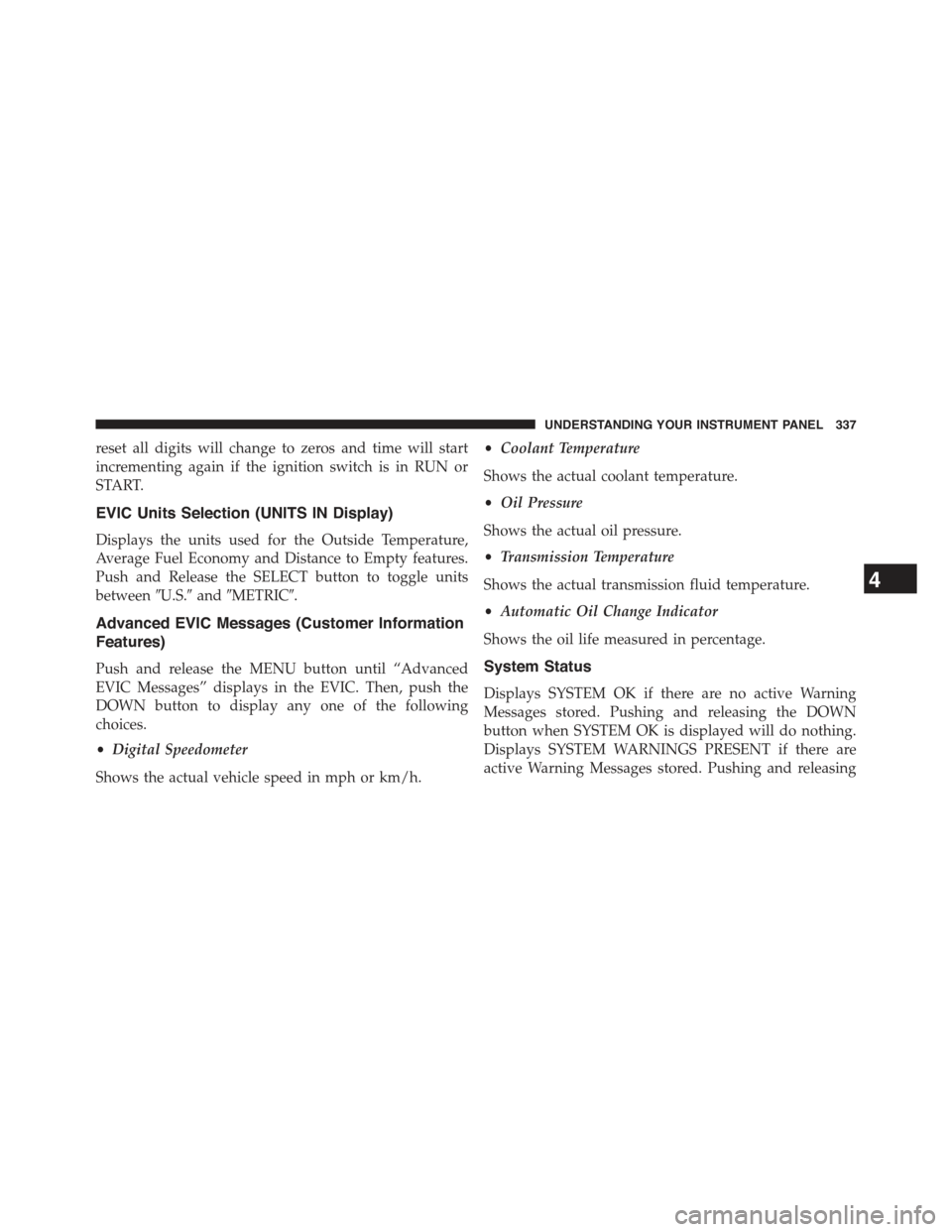
reset all digits will change to zeros and time will start
incrementing again if the ignition switch is in RUN or
START.
EVIC Units Selection (UNITS IN Display)
Displays the units used for the Outside Temperature,
Average Fuel Economy and Distance to Empty features.
Push and Release the SELECT button to toggle units
between#U.S.#and#METRIC#.
Advanced EVIC Messages (Customer Information
Features)
Push and release the MENU button until “Advanced
EVIC Messages” displays in the EVIC. Then, push the
DOWN button to display any one of the following
choices.
•Digital Speedometer
Shows the actual vehicle speed in mph or km/h.
•Coolant Temperature
Shows the actual coolant temperature.
•Oil Pressure
Shows the actual oil pressure.
•Transmission Temperature
Shows the actual transmission fluid temperature.
•Automatic Oil Change Indicator
Shows the oil life measured in percentage.
System Status
Displays SYSTEM OK if there are no active Warning
Messages stored. Pushing and releasing the DOWN
button when SYSTEM OK is displayed will do nothing.
Displays SYSTEM WARNINGS PRESENT if there are
active Warning Messages stored. Pushing and releasing
4
UNDERSTANDING YOUR INSTRUMENT PANEL 337
Page 563 of 695
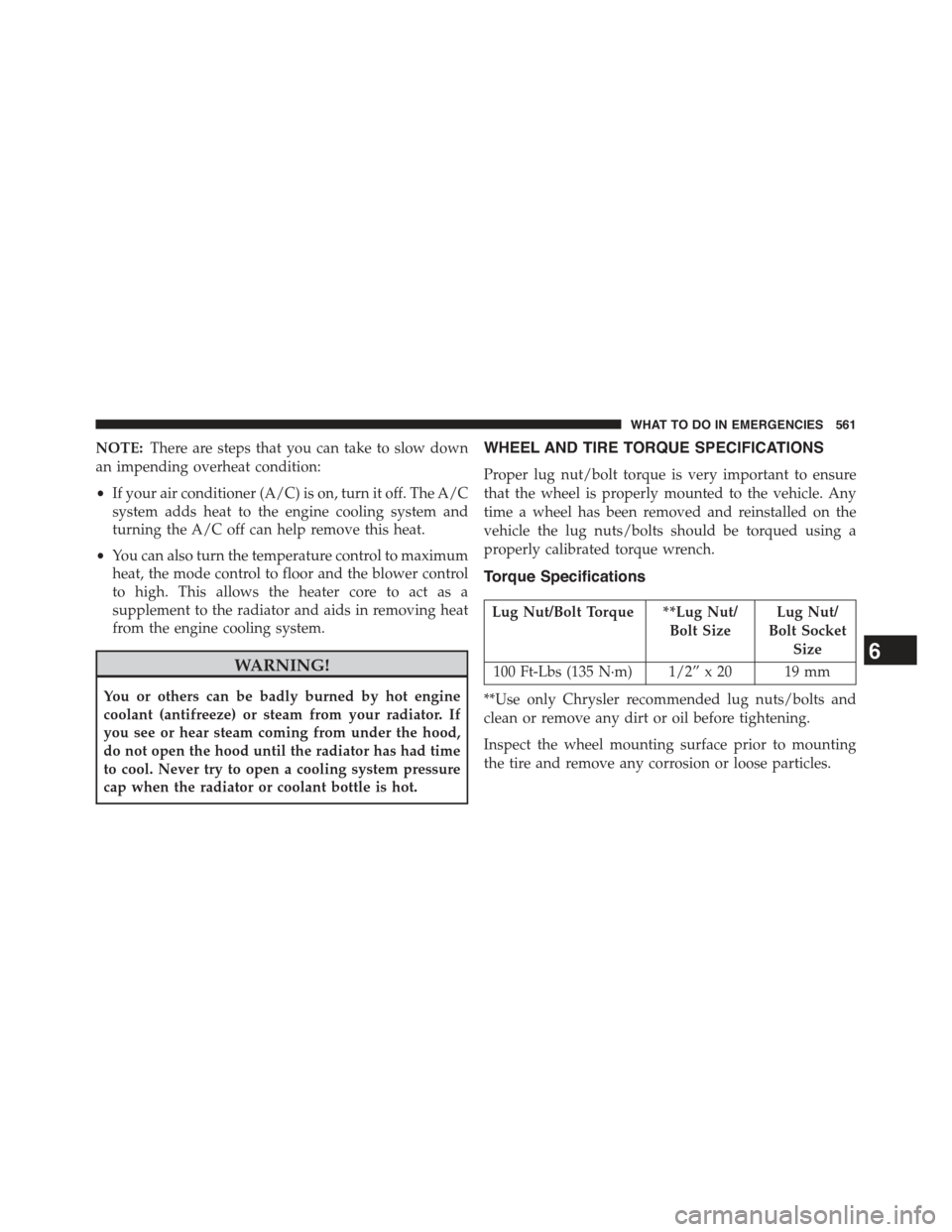
NOTE:There are steps that you can take to slow down
an impending overheat condition:
•If your air conditioner (A/C) is on, turn it off. The A/C
system adds heat to the engine cooling system and
turning the A/C off can help remove this heat.
•You can also turn the temperature control to maximum
heat, the mode control to floor and the blower control
to high. This allows the heater core to act as a
supplement to the radiator and aids in removing heat
from the engine cooling system.
WARNING!
You or others can be badly burned by hot engine
coolant (antifreeze) or steam from your radiator. If
you see or hear steam coming from under the hood,
do not open the hood until the radiator has had time
to cool. Never try to open a cooling system pressure
cap when the radiator or coolant bottle is hot.
WHEEL AND TIRE TORQUE SPECIFICATIONS
Proper lug nut/bolt torque is very important to ensure
that the wheel is properly mounted to the vehicle. Any
time a wheel has been removed and reinstalled on the
vehicle the lug nuts/bolts should be torqued using a
properly calibrated torque wrench.
Torque Specifications
Lug Nut/Bolt Torque **Lug Nut/
Bolt Size
Lug Nut/
Bolt Socket
Size
100 Ft-Lbs (135 N·m) 1/2” x 20 19 mm
**Use only Chrysler recommended lug nuts/bolts and
clean or remove any dirt or oil before tightening.
Inspect the wheel mounting surface prior to mounting
the tire and remove any corrosion or loose particles.
6
WHAT TO DO IN EMERGENCIES 561
Page 592 of 695
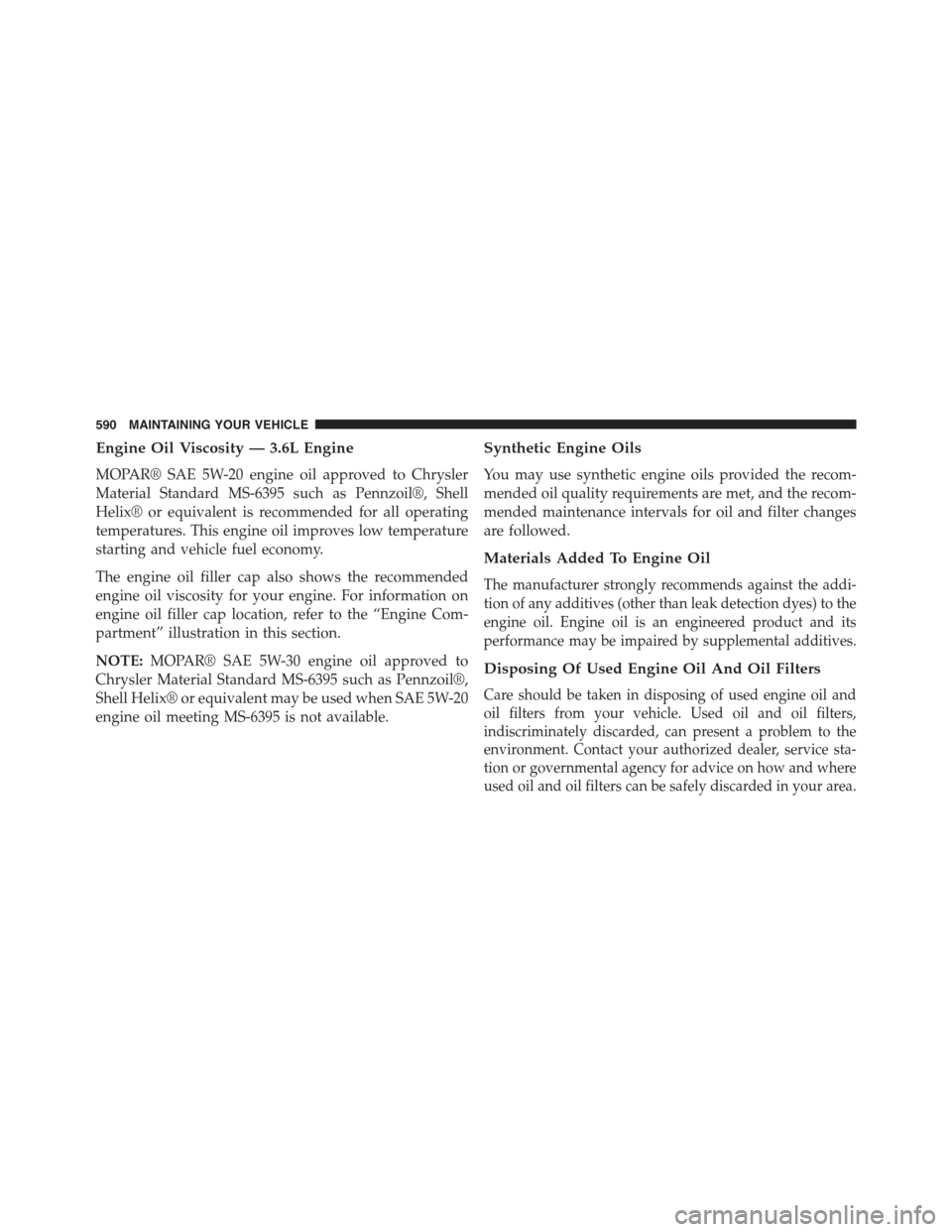
Engine Oil Viscosity — 3.6L Engine
MOPAR® SAE 5W-20 engine oil approved to Chrysler
Material Standard MS-6395 such as Pennzoil®, Shell
Helix® or equivalent is recommended for all operating
temperatures. This engine oil improves low temperature
starting and vehicle fuel economy.
The engine oil filler cap also shows the recommended
engine oil viscosity for your engine. For information on
engine oil filler cap location, refer to the “Engine Com-
partment” illustration in this section.
NOTE:MOPAR® SAE 5W-30 engine oil approved to
Chrysler Material Standard MS-6395 such as Pennzoil®,
Shell Helix® or equivalent may be used when SAE 5W-20
engine oil meeting MS-6395 is not available.
Synthetic Engine Oils
You may use synthetic engine oils provided the recom-
mended oil quality requirements are met, and the recom-
mended maintenance intervals for oil and filter changes
are followed.
Materials Added To Engine Oil
The manufacturer strongly recommends against the addi-
tion of any additives (other than leak detection dyes) to the
engine oil. Engine oil is an engineered product and its
performance may be impaired by supplemental additives.
Disposing Of Used Engine Oil And Oil Filters
Care should be taken in disposing of used engine oil and
oil filters from your vehicle. Used oil and oil filters,
indiscriminately discarded, can present a problem to the
environment. Contact your authorized dealer, service sta-
tion or governmental agency for advice on how and where
used oil and oil filters can be safely discarded in your area.
590 MAINTAINING YOUR VEHICLE
Page 611 of 695
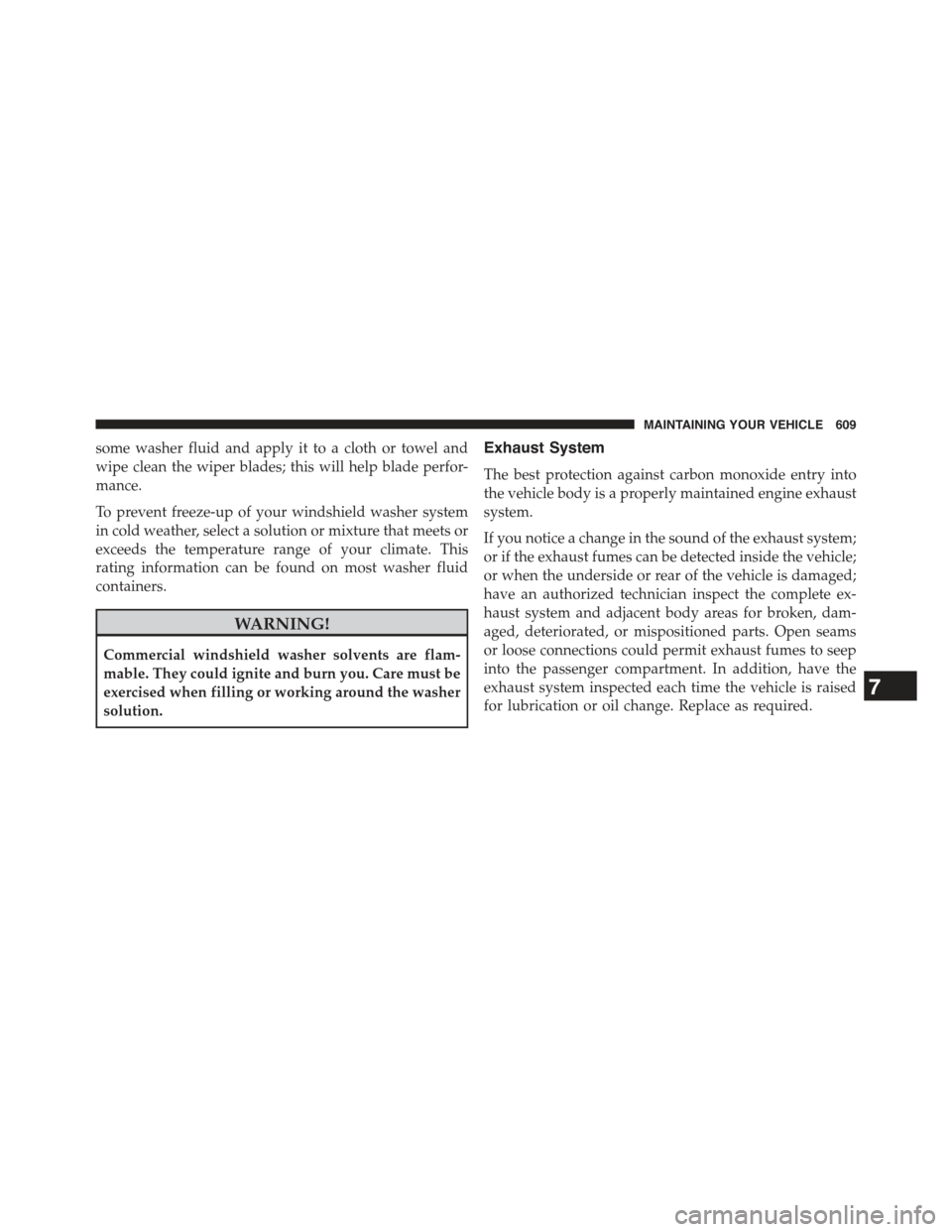
some washer fluid and apply it to a cloth or towel and
wipe clean the wiper blades; this will help blade perfor-
mance.
To prevent freeze-up of your windshield washer system
in cold weather, select a solution or mixture that meets or
exceeds the temperature range of your climate. This
rating information can be found on most washer fluid
containers.
WARNING!
Commercial windshield washer solvents are flam-
mable. They could ignite and burn you. Care must be
exercised when filling or working around the washer
solution.
Exhaust System
The best protection against carbon monoxide entry into
the vehicle body is a properly maintained engine exhaust
system.
If you notice a change in the sound of the exhaust system;
or if the exhaust fumes can be detected inside the vehicle;
or when the underside or rear of the vehicle is damaged;
have an authorized technician inspect the complete ex-
haust system and adjacent body areas for broken, dam-
aged, deteriorated, or mispositioned parts. Open seams
or loose connections could permit exhaust fumes to seep
into the passenger compartment. In addition, have the
exhaust system inspected each time the vehicle is raised
for lubrication or oil change. Replace as required.
7
MAINTAINING YOUR VEHICLE 609
Page 623 of 695
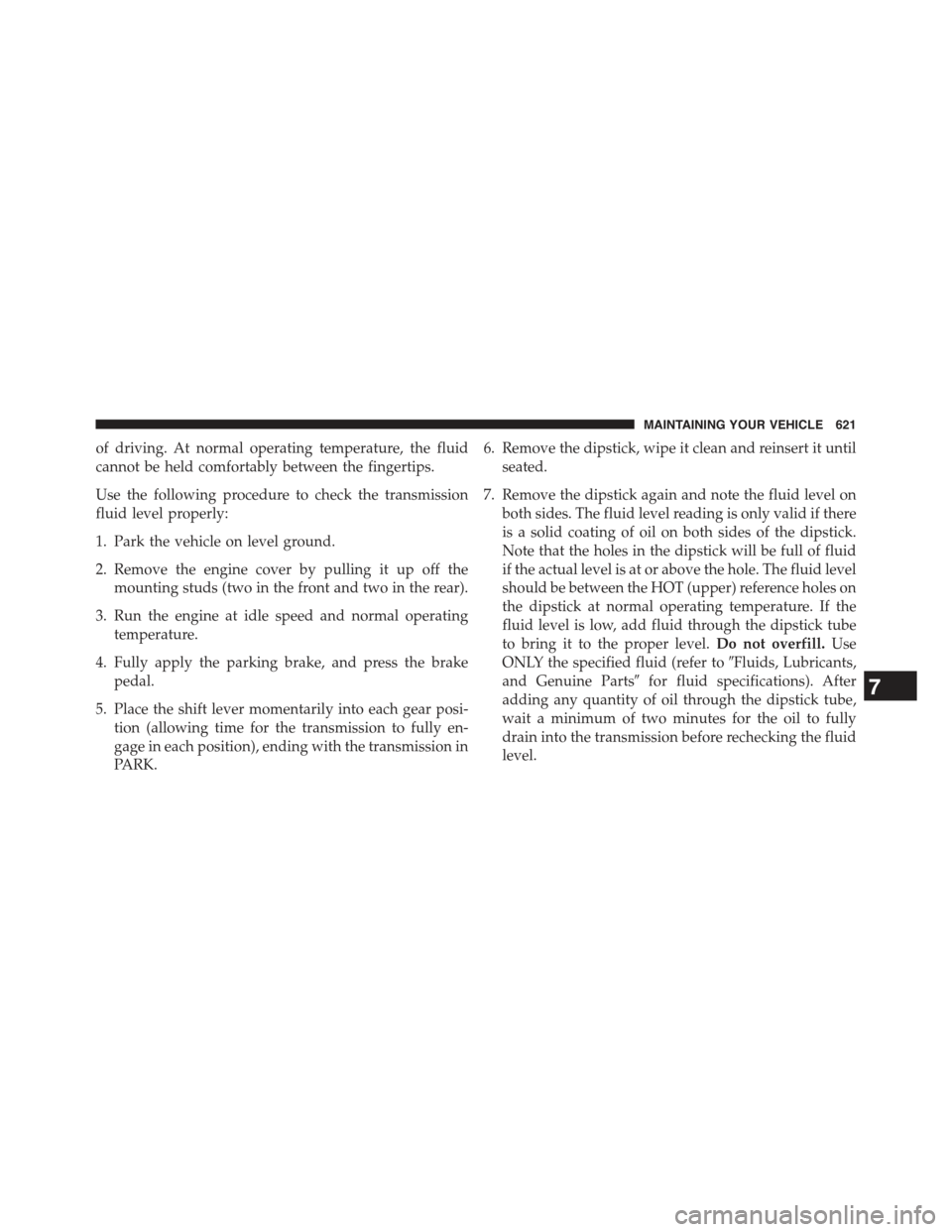
of driving. At normal operating temperature, the fluid
cannot be held comfortably between the fingertips.
Use the following procedure to check the transmission
fluid level properly:
1. Park the vehicle on level ground.
2. Remove the engine cover by pulling it up off the
mounting studs (two in the front and two in the rear).
3. Run the engine at idle speed and normal operating
temperature.
4. Fully apply the parking brake, and press the brake
pedal.
5. Place the shift lever momentarily into each gear posi-
tion (allowing time for the transmission to fully en-
gage in each position), ending with the transmission in
PARK.
6. Remove the dipstick, wipe it clean and reinsert it until
seated.
7. Remove the dipstick again and note the fluid level on
both sides. The fluid level reading is only valid if there
is a solid coating of oil on both sides of the dipstick.
Note that the holes in the dipstick will be full of fluid
if the actual level is at or above the hole. The fluid level
should be between the HOT (upper) reference holes on
the dipstick at normal operating temperature. If the
fluid level is low, add fluid through the dipstick tube
to bring it to the proper level.Do not overfill.Use
ONLY the specified fluid (refer to#Fluids, Lubricants,
and Genuine Parts#for fluid specifications). After
adding any quantity of oil through the dipstick tube,
wait a minimum of two minutes for the oil to fully
drain into the transmission before rechecking the fluid
level.
7
MAINTAINING YOUR VEHICLE 621